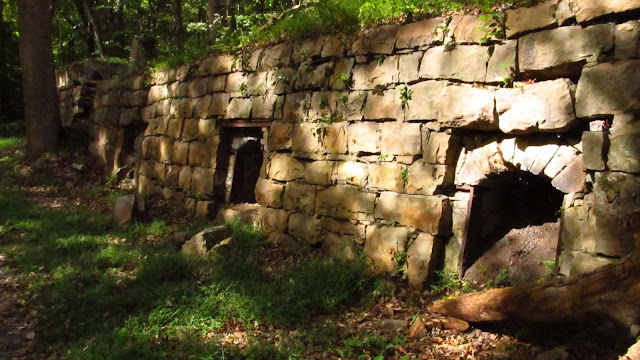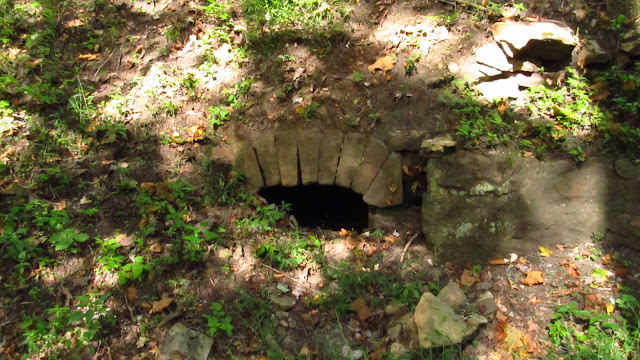Today we were heading back from a trip to the Great Smoky Mountains and decided to stop off in Nuttallburg, WV to check out the ruins of the Nuttallburg mine and coke works. The Nuttallburg site has been partially restored by the National Park Service. It is being preserved as an example of the mining complexes that once lined the New River Gorge for future generations.
The road getting down here is pretty rough. The first 6 miles off Route 19 were fine, but the last 4 miles on narrow gravel roads were a little rough for what I was driving. By the time we got down here my girlfriend was not at all thrilled by what I was putting her car through, there was still 200 miles to drive, and for a guy that's used to the Youghiogheny and Conemaugh Rivers these different varieties of snakes were simply freaking me out. There is much more to check out including the head house and portal entrance. These can be found on other sites online. Today I just got a chance to check out the tipple and coke ovens.
Anyway, the site dates back to the 1870's. John Nuttall, an English immigrant laid out the town in anticipation of the Chesapeake and Ohio Railroad coming through the gorge. By the time the railroad arrived in 1873, the town was built and ready. The mine that went along with the town was the second in the New River Gorge to ship its coal to outside markets. The portal of the mine was located hundreds of feet above the tipple and was delivered through a massive conveyor over the valley. By the turn of the century Nuttallburg was a very active mining community. John Nuttall passed away in 1897 and the mine was kept open by his heirs until the 1920's. After this Nuttallburg became a captive mine by Henry Ford who shipped the coke to the Ford Motor Company's steel mills in Dearborn, Michigan. Operating under the name of the Fordson Coal Company, Ford updated many of the mine facilities during this time. In 1928 Ford sold the mine to the New River Coal Corporation. After this, the mine was operated by at least two other companies until closing for good in 1958. Nuttallburg became a ghost town soon after the mine closed. In 1998 descendants of the Nuttall family transferred ownership to the National Park Service.
In my opinion this is exactly what we should have at Shoaf, right here in Southwestern Pennsylvania. Instead of numerous batteries of decaying coke ovens, a massive rusting tipple and larry tracks, we too could have a restored interpretive area for future generations of Pennsylvanians. Unfortunately the land owners at Shoaf do not share this vision at this time.
 |
| There are nice signs like this throughout the site telling the history and other information. |
 |
| Heading back toward the tipple on a well manicured trail. |
 |
| The tipple. |
 |
| Wonderful. |
 |
| Intact hardware under the tipple. |
 |
| These tracks are no longer used by trains but they add great detail to the site. |
 |
| Part of the massive conveyor system connecting the tipple to the mine. |
 |
| A couple more views of the tipple. |
 |
| The conveyor stretching across the valley floor. |
 |
| These coke ovens are much different than what we're used to. |
 |
| For one, they're very small. |
 |
| Some of the C&O siding tracks leading away from the tipple. |
 |
| A nice path leading through the coke ovens. |
 |
| A mostly buried coke oven. |
 |
| The retaining walls and outside of these ovens are all made of cut stone. No bricks other than the firebrick inside. |
 |
| The inside of one of the ovens. Much smaller than Pennsylvania ovens. |
 |
| Heading down the nice path. |
 |
| Another inside view. |
 |
| The ovens at the end further from the tipple were more intact. The insides were pretty much collapsed though. |
 |
| The doors still retain some nice frame hardware. |
 |
| This one is sealed shut. |
 |
| The sign telling us this was the company store's foundation. Everything in this store would be covered in soot and dust including these people. |
 |
| The back side of the bank of ovens. A nice path here too. |
 |
| Walking away from the snake and back toward the tipple. |
 |
| Another shot of the conveyor. |
 |
| Some old rusting equipment lying around. This looks like it could have been part of a coke pulling machine. |
 |
| Another shot of the tipple. |
 |
| This is just amazing the way it climbs the hill. |
 |
| Underneath the conveyor. |
 |
| Parting shot. Look at all the signs! There is nothing I enjoy more than fighting my way through the brush and mud to get to coke ovens, but this would be so nice to have in our area. |
 |
| This is on the way out. These were pillars from a pedestrian bridge crossing the New River that connected the two communities on each side of the river. |




















